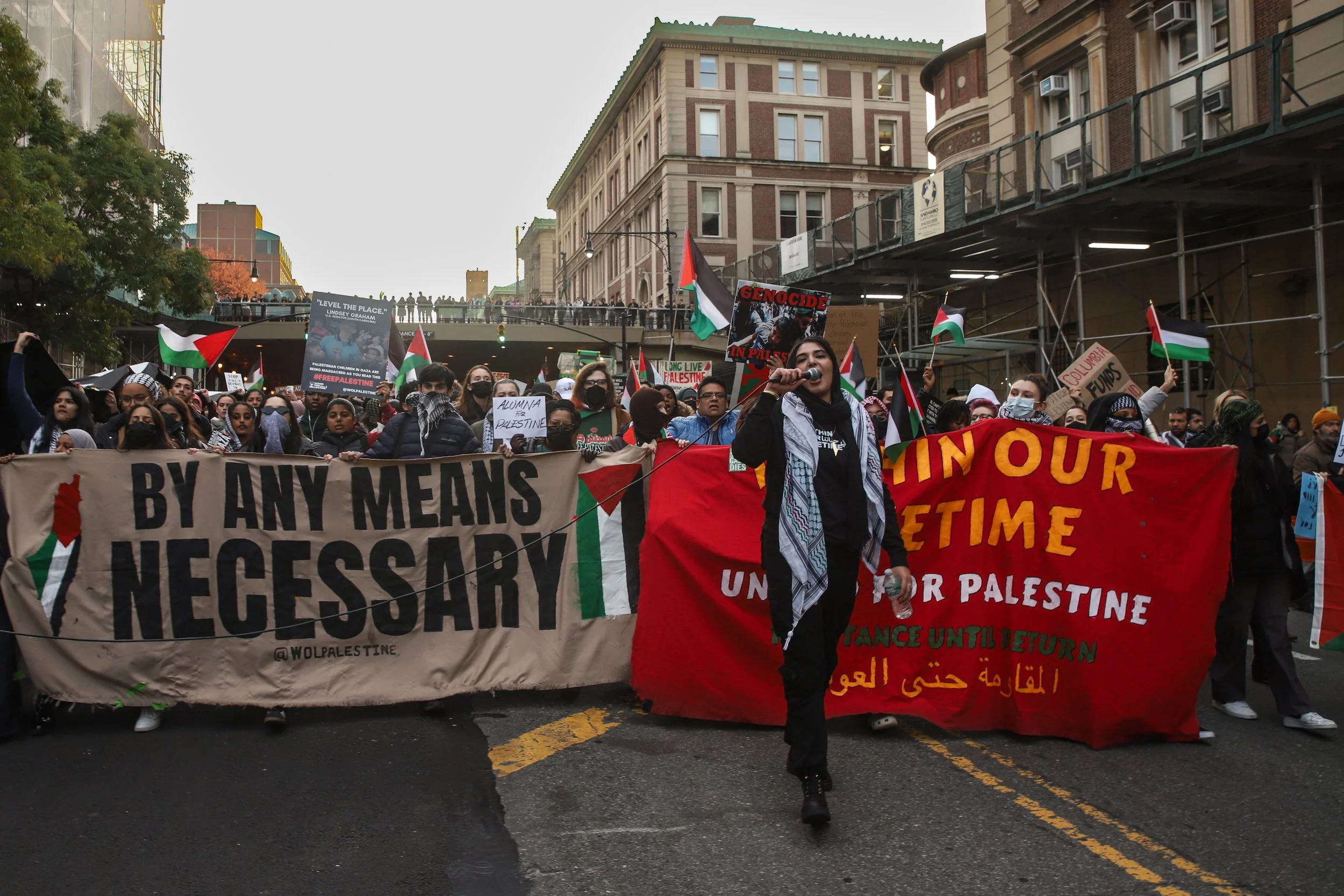I am both pleased and troubled by the political ferment on American college and university campuses. Pleased, because political expression is an essential part of citizenship – and citizenship (as I broadly define it) is the only reason to get an education.
Even if you vehemently disagree with their views, as I often do, the students protesting in recent weeks for Israel and for Palestine are acting as citizens. The problem, as I see it, is that they’re unequivocally taking sides in a conflict that has more than two sides, and failing to consider moral considerations (human life and safety) that transcend the usual political boundaries. Part of going to college is learning to grapple with such complexities.
Protesters at a rally against the suspension of Jewish Voices for Peace (JVP) and Students for Justice in Palestine (SJP) at Columbia University on November 15th 2023. Photo by Mark Banchereau.
What troubles me more is politics in the classroom – and again, it’s a problem of focusing on two sides of a multi-sided issue. (I write about this in Chapter 13 of Inside the Liberal Arts.)
The moral overlaps uneasily with the political. All students need to be respected and heard, and all viewpoints tolerated, with limited exceptions for hatred, incitement to violence, and threats to public safety. As laboratories of citizenship, classrooms must not be unduly politicized, because democracy is about contesting political questions, not deciding them (or pretending there’s only one legitimate side). College can’t make you a better person. But it can make you a more effective citizen.
Starting from there, we need to acknowledge other challenges. One is that exposure to unwelcome viewpoints is not a form of harm from which students need protection. Trigger-warnings and “safe spaces” are evasions of the responsibility of learning institutions. Freedom of speech and academic freedom compel us to err on the side of more, not less, of these precious democratic rights.
Another is that students, especially in these contentious days, bring identities to school, and identity politics ultimately degrades democracy. We should all cherish who we are and respect others who are different. But students also need to grow with, and beyond, their identities into a civic space where everyone matters. Who you are isn’t the point of your education. Neither, for that matter, is how you want the world to be – but that’s a longer discussion.
As for the classroom itself: I once taught a course on media and ideology, and it was hard to find a balance of opposing views. I failed to make such a balance part of the course. My bad.
One problem was that the left has various and complex views about the nexus of media and politics, whereas the right has no such theories: it simply has the view that the media are too liberal – which deserves to be discussed. But that imbalance didn’t excuse my failure.
I cared about my students, but I didn’t care who they were identity-wise. I just wanted to help them to think and learn. In that respect, I got at least part of the job done. Classrooms have a different political calculus, because within them, the main job is to learn something in particular. Politics can’t be walled off without stifling discussion, and some subjects are more political than others.
The limits to free-speech absolutism on campuses, it seems to me, are essentially two-fold. One is the hate-and-violence exception. The other is that not everything is political, including most of the STEM fields, much (but not all) of the sciences, and some of the social sciences and humanities. The latter are trickier because they more directly involve the study of human values. Art, literature, and history are often political, and ignoring their political dimension is a non-starter. But at the same time, resolving or even airing political debates isn’t the main reason to sign up for an Art History class. The more elusive problem is where exactly to draw the boundaries in determining what to teach or study and how to teach or study it.
The far right insists that we shouldn’t talk about race or gender at all. That idea is deeply wrongheaded. Critical race theory, feminism, and queer studies, for example, shine light on important aspects of human experience that have hitherto lain too much in the dark. Yet they can also become single lenses for seeing everything – or political agendas masquerading as inquiry. That doesn’t work either; ideology is not inquiry. Social-justice issues have their place (and I’m all for them). But that place isn’t everywhere.
In sum, colleges and universities can’t insulate themselves from politics, in the classroom or on the quad. But higher education is about something larger than progressive (or regressive) change. It’s about learning, the democratic process, and citizenship. It’s about seeing sides, not taking sides.
Schools lose their legitimacy as proto-democratic institutions if they ban books or boycott certain forms of discourse, or come to be viewed as ideological strongholds. Like formal democratic institutions – and unlike the media, which must be more diverse – schools need to sponsor the spectrum, not tilt it. To make matters worse, it’s a warped spectrum, because in recent years one side has become deeply anti-democratic.
How politics penetrates society, and how far it penetrates, are important questions for inquiry; actual advocacy, not so much. I don’t know exactly where to draw the line, and I’m not a teacher; but the question needs to be debated. I’m still struggling with it, and may have gotten some important things wrong. Teachers and students who are less confused might want to give that struggle a try.

